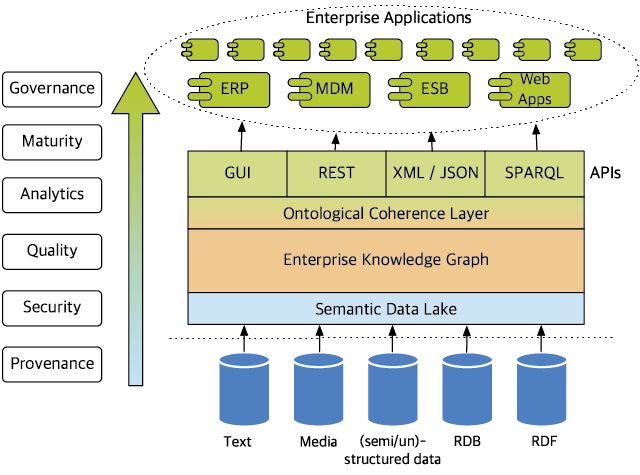»Enterprise Knowledge Graphs (EKGs)« are realisations of Linked Enterprise Data, creating valuable business insights by bringing together semantic technologies and enterprise data infrastructures. EKGs go beyond data integration and also enable the next generation Artificial Intelligence applications. The semantics underlying EKGs provide machines with a unique advantage of understanding the meaning of large data volumes, allowing for instant linking, reasoning and automation.
EKGs consist of a semantic network of concepts, properties, instances and relationships representing and referencing foundational and domain knowledge within or across different enterprises. They use a knowledge representationformalism (typically RDF, RDF-Schema, OWL) to holistically represent multi-domain enterprise knowledge including:
- instance data (ground truth) from open (e.g. DBpedia, WikiData) and private data sources (e.g. supply chain data, product models),
- derived and aggregated data,
- schema data (vocabularies, ontologies, taxonomies)
- categorizing entities,
- meta-data (e.g. provenance, versioning, documentation, licensing),
- links between internal and external data,
- mappings to data stored in other systems and databases.
The »Enterprise Information Systems EIS« department at Fraunhofer IAIS investigates formal conceptual frameworks for designing, maintaining and exploiting such graphs:
- developing strategies for the semi-automatic construction of such graphs
- combining proprietary enterprise data and relevant open data repositories
- methods for retaining semantic coherence across the entire graph
- Improving query performance as well as governance and access control
- developing methods for the operation of EKG-driven enterprise information systems
- establishing data value chains across organisational boundaries
- integrating big data processing pipelines for analysis and generating insights.
EKGs are positioned on top of Semantic Data Lakes, which consume raw data in various structured and unstructured formats and allow for on-the-fly data integration. The ontological coherence layer on top of the EKG consists of a set of ontologies covering different aspects of the contents, and provides unified means to interact and communicate with the EKG. The integrated data is then transformed into knowledge and exposed via the API layer to various enterprise information systems and applications.
